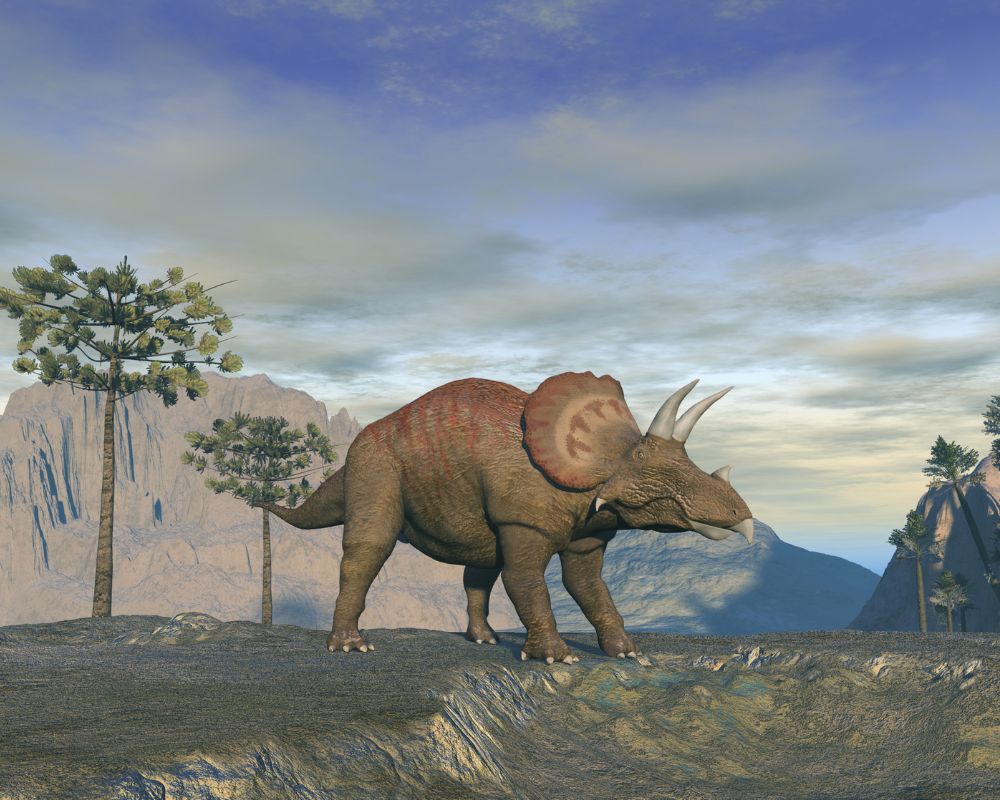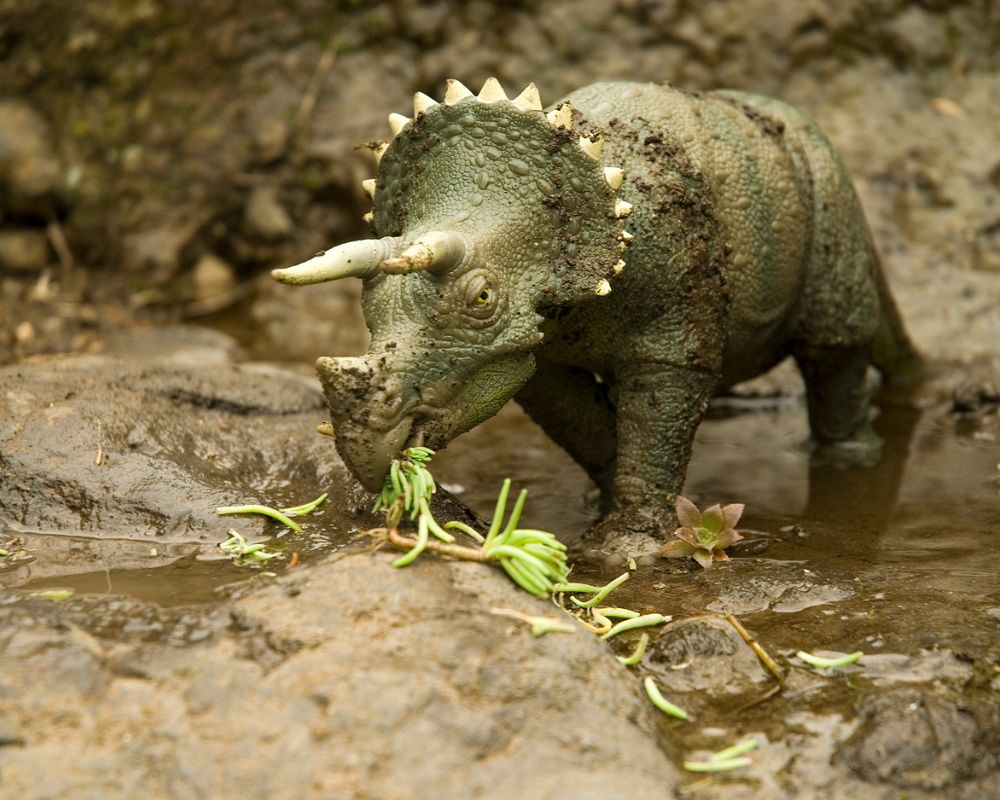A Triceratops was a horned dinosaur from the late Cretaceous period. It lived in North America until dinos went extinct 66 million years ago. There were two species of Triceratops, T. horridus, and a slightly smaller T. prorsus, which lived close by but not together.
Table of Contents
Some Quick Facts About the Triceratops

| Name | Triceratops horridus (Horrid three-horned face) |
| Type of dinosaur | Ceratopsian dinosaur (Horned dinosaur) |
| Territory | Dry forests and plains with plenty of palms and ferns, North America |
| Size | Large dino-30 feet long, 7-10 feet tall, and 12,000 pounds |
| Color | Brown or greenish skin for camouflage |
| Interesting Characteristics | Neck frills, three horns |
| Diet | Herbivore |
| Major Threats | Large carnivores like Tyrannosaurus rex, climate, and natural disasters about 68-66 million years ago |
Triceratops were Ceratopsid dinosaurs discovered in North America. They had two large brow horns over their eyes and a bony nose horn like a Rhinoceros. Triceratops’ large bony frill protected its neck and attracted mates.
What Type of Dino was the Triceratops?

The Triceratops was a horned dinosaur from the group Ceratopsia. They had beaked mouths, large frills, and horns. Nedoceratops, Torosaurus, and Centrosaurus were all Ceratopsian dinos.
The earliest Ceratopsian dinosaurs came from Asia in the Late Jurassic period. As they’ve evolved, the horns have gotten bigger. All Ceratopsian dinosaurs were herbivores and walked on four legs.
What’s Behind the Name?

Triceratops horridus means Horrible three-horned face. “Tri,” of course, means three, and “ceratops” means horned face. “Horridus” means horrid or horrible.
When Triceratops’ bones emerged for the first time, they were scary. They didn’t look like other dinos, with long horns coming out just above their eye sockets. Paleontologists made all sorts of amazing finds in the 1800s, and Triceratops was one of the most unique-looking dinosaur fossils!
Did Triceratops’ horns grow back if broken?
Triceratops’ horns did not grow back. Once they broke off, they remained broken forever. Since the horns were living bone, the bone would heal after being broken.
Triceratops’ horns were a permanent part of their skeleton. They grew where the neck frill connected with the forehead of the Triceratops.
What was the Neck Frill Used for?
The Triceratops’ large frill served for protection and sometimes to attract mates. The hard bony frill made up about half of the Triceratops’ head.
Triceratops would use their neck frill as protection against predators and each other. The biggest Triceratops skeleton found to date had an injury to its neck frill caused by another Triceratops. This fossil was named Big John and came from South Dakota’s Hell Creek Formation.
Was the Triceratops Alive with the T-Rex?
Being eaten by the Tyrannosaurus rex was one of the biggest dangers the Triceratops faced! The massive T-rex was known to eat the Triceratops and other herbivores. T-rex bite marks have been found on some Triceratops fossils.
Still, the Triceratops wasn’t completely helpless against T-rex attacks. The Triceratops stayed close to other herbivores for protection, and their long, sharp brow horns could help against the T-rex.
The Triceratops could ram the T-rex and knock the predator over. Once the T-rex was on its side, the short-armed carnivore struggled to get back up. That gave the Triceratops and other herbivores a chance to run away!
How many Triceratops have been found?
Two species of Triceratops have been identified so far. These species are T. horridus and T. prorsus. T. prorsus was slightly smaller than T. horridus, but not by much.
Paleontologist John Scannella and others found that T. horridus and T. prorsus lived nearby but not together. They came to this conclusion because the fossils of the two species haven’t emerged grouped yet. All the Triceratops fossils found so far have only one species per group.
Triceratops was one of the most interesting dinosaur fossil finds in the 1800s. Over 100 years later, paleontologists are still unearthing new Triceratops fossils. Paleontologists like Jack Horner and John Scannella continue researching the fascinating Triceratops today.
A complete Triceratops skeleton has yet to emerge. The first Triceratops fossils were just skulls.
Where Were Triceratops Fossils Discovered?
The very first Triceratops fossil came up in Denver, Colorado. Originally paleontologist O.C. Marsh thought the Triceratops skull was from an ancient bison. About a year and three Triceratops skulls later, Marsh realized these were dinosaur fossils.
Triceratops fossils have been found in bone beds all over North America. Bone beds are groups of dinosaur fossils found together. Triceratops fossils surfaced in Colorado, Montana, South Dakota, Wyoming, and parts of Canada.

